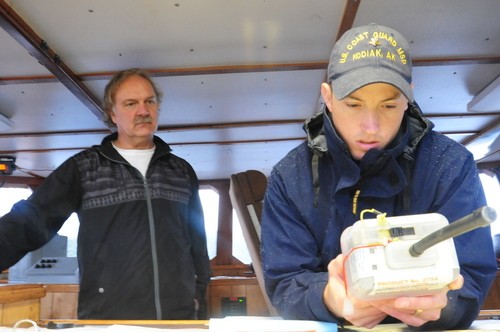The Harsh Reality of US Coast Guard Migrant Policy
by John Konrad (gCaptain) When merchant and cruise ships rescue migrants at sea, they offer more than just a lifeline from the perilous waters; they provide critical sustenance and care....




We pooled together our resources and reached out to search and rescue experts to create the below list of frequently asked questions about EPIRBs. Read up, and share with your family and friends so you all can “boat responsibly!”
What exactly is an EPIRB?
EPIRB stands for emergency position-indicating radio beacon. It is a device that is designed to transmit a distress signal if you get into trouble. No matter where you are in the world, an EPIRB sends a signal to emergency responders through a satellite system called Cospas-Sarsat.
Are there different types of EPIRBs?
Yes, there are two types of EPIRBs that can currently be used in the U.S. – Category I and Category II. Category I EPIRBs can be activated either manually or automatically while Category II EPIRBs can only be activated manually. Both Category I and Category II devices transmit a 406 MHz frequency.
In February 2009, the Federal Communications Commission phased out the use of another type of EPIRB that transmitted a 121.5 MHz frequency, and these devices may no longer be used, marketed or manufactured in the U.S.
I just bought an EPIRB. What is the first thing I should do?
Register it! All beacons are required to be registered by requirement of the Federal Communications Commission. There are several ways to register you EPIRB, but the easiest is via the beacon registration website. To find out other ways to register your device, click here.
Once I have an EPIRB aboard my vessel, how does it work?
Because an EPIRB can be automatically or manually activated, it is important you keep this in mind for where you store or mount the device on your vessel. If you have an EPIRB that activates automatically, it will typically have a hydro-static release mechanism that allows the beacon to release from its bracket. Once free from its mounting, the device floats to the surface and transmits a signal. A beacon has to sink to roughly three meters before it can activate, so remember to take this into account when you mount an automatic EPIRB.
I want to make sure my beacon works. Can I test it?


A 406 MHz emergency beacon should only be activated when you are in grave and eminent danger. Most EPIRB activation switches have a test position. This test position allows the entire unit, including electronics, battery and antenna, to be tested without generating a false alarm.
Check the manufacturer’s instructions on how to use the “test” feature in non-emergency situations. There are also boating supply stores or Coast Guard units nationwide that can assist you.
What is a false alert?
A false alert is an activation of an emergency beacon in a non-distress situation. Examples of false alerts include accidentally turning on an emergency beacon, improperly testing a beacon or incorrectly mounting an emergency beacon so that it falls out of its bracket and activates.
One of the more frequent causes of false alerts is when the beacon is removed from its bracket without first switching it to the “off” position. It is important you inform your passengers of this as well, as many times a curious passenger will touch the device. The Cospas-Sarsat satellite system is very good at detecting emergency beacons, so an activation of any beacon, even for just a few seconds, can be detected.
What should I do if I have accidentally activated my emergency beacon?
If your beacon is activated and you are not in an emergency, you should contact the appropriaterescue coordination center without delay. Click here to find the rescue coordination center closest to you. If you cannot contact a rescue coordination center directly, you should use any means available to inform the appropriate authorities that a false alert has been transmitted and should be cancelled.
Am I required to carry an EPIRB?
In general, U.S. commercial fishing vessels, uninspected passenger vessels that carry six or more people and uninspected commercial vessels are the only vessels legally required to carry an EPIRB. Regardless of the requirements, if you operate a vessel, an emergency beacon could be just as instrumental as wearing a life jacket in saving your life.
This is a lot of information to remember. If there were one thing I needed to remember about EPIRBs what would it be?
We reached out to the search and rescue office at Coast Guard headquarters for help on this one, and their answer was simple – Register your beacon.
“The most important thing for effective operation of beacons is for the beacon to be properly registered,” said Lt. Cmdr. Mark Turner, the Coast Guard’s Sarsat liaison officer. “Registering your beacon means the Coast Guard can be in contact with the folks back home who can provide search and rescue responders with more information to assist in a search.”
This post was originally written by LTJG Stephanie Young for the CG Compass blog.
Join the gCaptain Club for curated content, insider opinions, and vibrant community discussions.


Join the 107,103 members that receive our newsletter.
Have a news tip? Let us know.
Access exclusive insights, engage in vibrant discussions, and gain perspectives from our CEO.
Sign Up




Maritime and offshore news trusted by our 107,103 members delivered daily straight to your inbox.



Essential news coupled with the finest maritime content sourced from across the globe.
Sign Up